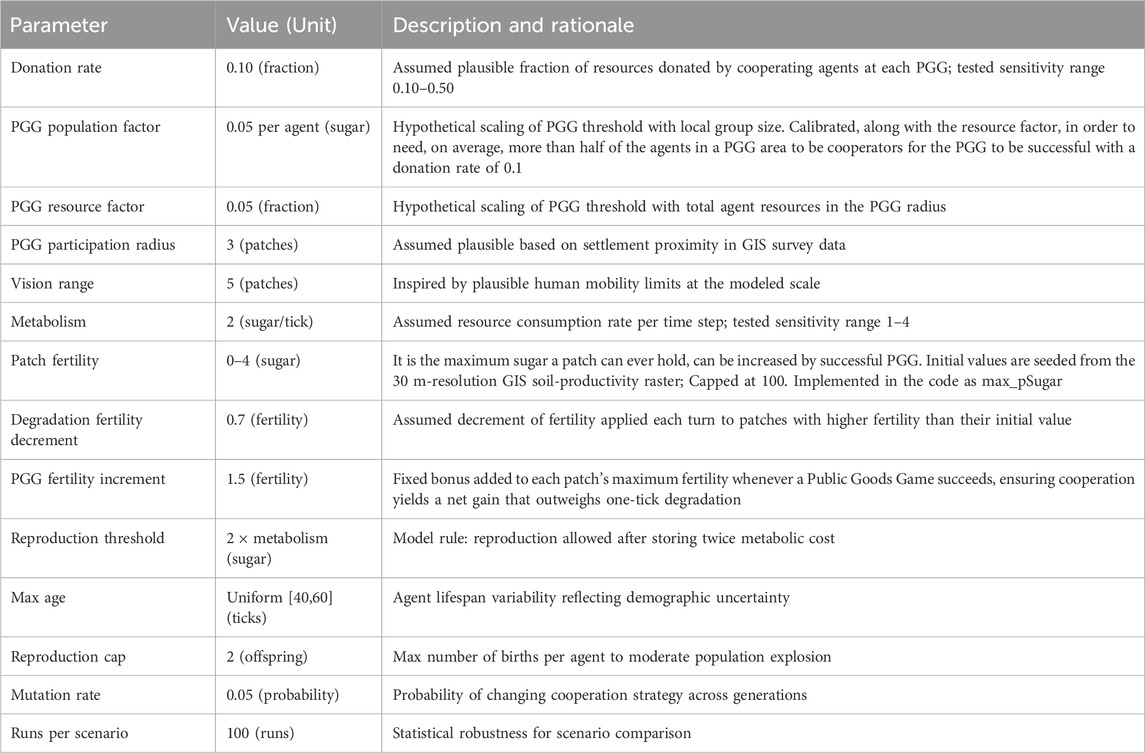- 1Laboratory of Agent Based Social Simulation, Istituto di Scienze e Tecnologie della Cognizione, National Research Council, Rome, Italy
- 2Dipartimento Ingegneria dell'Informazione e Scienze Matematiche, Università di Siena, Siena, Italy
- 3Dipartimento Asia, Africa e Mediterraneo, Univesità di Napoli L'Orientale, Napoli, Italy
- 4GISC-Dep.to de Matemáticas, Universidad Carlos III de Madrid, Getafe, Spain
Introduction: This study intends to test the hypothesis that, contrary to traditional interpretation, the social structure of the polity of Aksum–especially in its early stages–was not characterized by a vertical hierarchy with highly centralized administrative power, and that the leaders mentioned in the few available inscriptions were predominantly ritual leaders with religious rather than coercive political authority. This hypothesis, suggested by the available archaeological evidence, is grounded in Charles Stanish's model, which posits that pre-state societies could achieve cooperative behavior without the presence of coercive authority.
Methods: Using agent-based modeling applied to data inspired by the Aksum civilization, we examine the dynamics of cooperation in the presence and absence of a Public Goods Game.
Results: Results show that while cooperative behavior can emerge in the short term without coercive power, it may not be sustainable over the long term, suggesting a need for centralized authority to foster stable, complex societies.
Discussion: These findings provide insights into the evolutionary pathways that lead to state formation and complex social structures.
1 Introduction
The evolution of complex societies has often been linked to the emergence of centralized, coercive authority capable of maintaining order and cooperation among large populations (Carneiro, 1970). Charles Stanish proposed that pre-state societies could exhibit cooperative behaviors without the presence of coercive power (Stanish, 2017), but that sustained cooperation likely requires some form of centralized authority. In this study, we explore this hypothesis by simulating a pre-state society inspired by data from the Aksum civilization using an agent-based model. The model includes a Public Goods Game (PGG) (Ledyard et al., 1995) to simulate cooperative behavior, aiming at understanding the conditions under which cooperation can emerge and be sustained without coercive mechanisms.
Situated in the mountainous regions of the northern Ethiopian plateau, from the second half of the 1st millennium BCE the area of Aksum progressively emerged among the polities of the northern Horn of Africa, extending throughout the 1st millennium CE its influence over an increasingly vast territory, which reached across the Red Sea to include part of present-day Yemen (Phillipson, 2012). Throughout its history, the so-called ‘Kingdom of Aksum’ was involved in long-distance trade and contacts with the Mediterranean, the Nile Valley, the Arab side of the Red Sea and the western Indian Ocean (Manzo and Starkey, 2005; Munro-Hay, 1982; Munro-Hay and Reade, 1996). It reached sophisticated levels of architectural expertise, one thinks, for example, of the great funerary stelae, some of which are among the largest monoliths ever erected in the world (Phillipson, 1977). It minted, a unique case in ancient Africa, its own currency with denominations in bronze, silver and gold (although, as the archaeological evidence suggests, the latter two were mainly used abroad and part of the local population still practiced barter as the main exchange system) (Munro-Hay and Juel-Jensen, 1995). Last but not least, it played a significant role in the geopolitical scenario of the Near East in the Late Antique period (Bowersock, 2013). Despite this, there is very little written documentation referable to this period in Aksum’s history, most consisting of inscriptions commemorating military raids or other achievements by chiefs (Fattovich, 2010). There are very few references to a bureaucratic/administrative apparatus, essential for the alleged centralised management of such a vast and diversified territory. For the earlier phases, written documentation is even poorer and inscriptions remain essentially celebratory and ritual in content (Bernand et al., 1991). Although inscriptions mention epithets translated as ‘king’, their number and content as well as the available archaeological evidence do not support, especially for the earliest phases, the traditional interpretation of these social entities as kingdoms or states, at least in the common understanding of the terms. Based on this, our paper discusses the preliminary results of an ABM-based study on the nature of the earliest forms of complex societies in this area and its possible development trajectories over time. It relies on firm archaeological and ethnographic data and explores concepts of clanship, cooperation, ritualized economy and leadership derived from cultural anthropology and allied disciplines (McIntosh, 1999).
2 Methodology
This paper proposes the development of an ABM aimed to describe the cooperative behavior of the Aksum population. This section describes the studies done by archaeologists and the mathematical model over which is made.
2.1 Archaeological studies and data acquisition
Due to its historical relevance, Aksum has been undoubtedly one of the most thoroughly archaeologically investigated sites of the northern Horn of Africa. Research in the area include both archaeological excavations and survey, which increased knowledge on the dynamics that underwent ancient Aksum’s emergence and subsequent development. Alongside data available in the scientific literature, two intensive archaeological survey projects conducted between 2005 and 2006 in the framework of the Italian Archaeological Expedition at Aksum of the University of Naples L’Orientale and the World Bank ‘Ethiopian Cultural Heritage Project’ concurred to provide a GIS-based archaeological map of the whole area of Aksum. The map includes an overall amount of 698 sites (settlements, monumental buildings, cemeteries, landscape infrastructures) distributed across an area of about 105 sq km (Sernicola, 2017). Geological, geoarchaeological and environmental studies enabled the generation of thematic maps on soil productivity, water resources distribution and slope gradient. This formed the basis for the reconstruction of ancient occupation dynamics, demographic trend and land-exploitation strategies in the area. GIS analysis showed that since the first millennium BCE, settlements were located according to three major environmental factors: a) close proximity to water resources (no more than 250 m from rivers, streams or water reservoirs), b) close proximity to more productive soil, and c) slope gradient (Sernicola, 2017).
2.2 Agent-based model
An agent-based model was developed to simulate the cooperative behavior of agents inspired by the Aksum civilization. The model includes agents with properties such as resource levels, metabolic needs, vision, and a probability of contributing to the public good. The PGG was implemented to simulate cooperative interactions, where agents could contribute a portion of their resources to a common pool, which in turn benefited the whole community if the collective donation met a defined threshold. Figure 1 reports the initialization of the model where the orange areas represent the proto Aksumite sites, the green the fertility, and the cyan the river in strict coherence with the knowledge emerging from archaeological studies. Our agent-based model integrates two complementary sets of features. First, we ground the spatial and demographic aspects of the simulation in high-resolution archaeological and GIS data from the Aksum region. This empirical foundation ensures that basic environmental constraints and initial settlement patterns closely mirror the real landscape of northern Ethiopia around the first millennium BCE. Second, we overlay a suite of theoretical mechanisms—drawn from evolutionary game theory and ecological modeling-that allow us to investigate how cooperation might emerge, persist, or fall apart in a pre-state society.
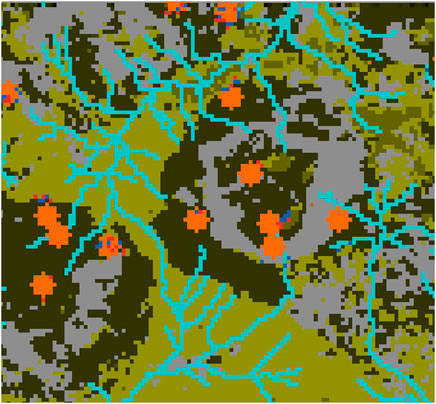
Figure 1. Initial state of the NetLogo simulation. The orange circles represent areas where the Public Goods Game (PGG) can be performed, centered at proto-Aksumite sites. Grey patches have zero fertility, while the green gradient represents varying fertility levels across the map. The cyan curves are rivers.
In practice, this dual approach means:
2.2.1 Empirical components
These elements are directly informed by archaeological evidence and spatial analyses:
2.2.2 Theoretical components
These rules and parameters are designed to probe cooperation dynamics beyond what the archaeological record alone can reveal:
Table 1 then lists every parameter and indicates whether it is data-driven or theoretical, making the model’s hybrid nature explicit.
The model was designed with two scenarios:
2.3 Public Goods Game
In classical Public Goods Games (PGGs), each agent in a group chooses whether to contribute a cost
In spatial extensions of the PGG, agents are placed on a grid and interact within a local neighborhood, typically defined by a Moore or von Neumann structure (Szabó and Fáth, 2007). Each agent plays multiple overlapping games with its neighbors, and the results depend on the spatial arrangement of cooperators and defectors. These models assume a fixed neighborhood and no agent movement.
Our model departs from this structure in two ways. First, agents move freely across space and can enter or leave cooperative zones. Second, rather than receiving individual payoffs, cooperation affects the environment itself by increasing patch fertility. In this sense, the “payoff” is externalized into the landscape.
2.3.1 The mechanism of PGG in the Aksum model
1. Identification of PGG Centers: The PGG is initiated at specific geospatial locations identified as proto-Aksumite site patches. These patches represent areas of early human settlement or resource concentration, loaded from GIS data.
2. Participation Radius: Each PGG center defines a radius within which agents (turtles) are eligible to participate. This radius represents the spatial influence of the PGG center and reflects the localized nature of resource sharing and cooperation in early societies.
3. Threshold Calculation: The threshold for a successful PGG is dynamically determined based on:
(a) A population-based threshold proportional to the number of agents within the radius.
(b) A resource-based threshold calculated as a fraction of the total resources (sugar) of the participating agents.
Mathematically, the success threshold
where:
Note that in the code (and pseudocode) there is a third component for the threshold, this is an element used to avoid bugs in the execution of the code that avoids PGG with threshold 0 to happen.
4. Agent Behavior: Agents within the participation radius evaluate their willingness to contribute based on their donation probability. In our model, donation is a binary trait: agents are either full cooperators or full defectors. If cooperative, an agent donates a fixed fraction (e.g., 10%) of its resources. Defectors donate nothing.
5. Outcome of the PGG: If the total donation
If the threshold is not met, no benefit is conferred.
2.3.2 Environmental update equation
Regardless of success or failure, fertility undergoes degradation over time (see Section 2.5). At each tick, patch
where:
This ensures that cooperation can temporarily boost fertility, but such gains decay in the absence of sustained collective action. For more details we provided the pseudo code of the mechanisms of the PGG in the Supplementary Appendix Algorithm 1.
2.3.3 Key differences from standard PGG frameworks
The PGG mechanism in the Aksum model differs from traditional implementations in the following ways:
1. Spatial Context: Traditional PGG models typically assume a non-spatial environment where participants interact globally or within fixed networks. In contrast, the Aksum model incorporates geospatial data to determine participation areas and thresholds, anchoring the game in a physical and historical context. Agents can enter or leave PGG zones, allowing for fluid, open-ended participation.
2. Dynamic Thresholds: Unlike standard models with static thresholds, the Aksum model thresholds adapt to the local population and resource availability, making the game more representative of real-world conditions.
3. Localized Benefits: The benefits of cooperation (fertility increases) are confined to the spatial area surrounding the PGG center, emphasizing the local impact of collective actions. This approach mirrors the dynamics of resource sharing in pre-state societies.
4. Integration with Environmental Feedback: The Aksum model links the success of the PGG to environmental feedback by adjusting the fertility of patches. This coupling highlights the interplay between social cooperation and ecological sustainability, a feature absent in many classical PGG models.
2.4 Reproduction, movement, and sugarscape foundations
Our model builds on the foundational Sugarscape framework (Epstein and Axtell, 1996) (see Supplementary Appendix Algorithms 2–5), in which agents collect resources (called “sugar”) from a landscape, consume a fixed amount per time step (their metabolism), and die if their resources run out or if they reach a maximum age. Agents move to nearby patches with the most sugar, and patches regenerate sugar each tick up to a predefined fertility maximum. This setup allows basic ecological dynamics like scarcity, competition, and reproduction to emerge from simple rules.
We retain these core elements—including metabolism, vision-based movement, and resource-based reproduction—as the ecological backbone of the Aksum model. On top of this, we add new mechanisms (such as the Public Goods Game) to simulate collective action and cooperation in pre-state societies.
The Aksum model incorporates reproduction and movement mechanisms to reflect dynamic population growth and resource-seeking behaviors, adding complexity to the simulation.
2.4.1 Reproduction mechanism
2.4.2 Movement mechanism
Vision-Based Movement: Agents scan their environment within a defined vision range for patches with higher fertility. Then they evaluate destinations based on resource availability and the number of other agents present, reducing competition and preventing overloading of fertile patches. Two agents cannot occupy the same patch at the same time.
2.5 Regrowth and degradation of resources in patches
Resource dynamics in patches are modeled through processes of regrowth and degradation, which simulate environmental feedback and sustainability. The regrowth mechanism follows Sugarscape’s standard rule, where each patch regenerates its resources up to a fixed maximum per tick. However, we extend this by introducing a degradation mechanism: when cooperation increases fertility beyond the baseline, this improvement decays over time in the absence of further cooperative action. This models ecological fragility, a feature not present in the original Sugarscape. The increment of fertility as a consequence of successful PGGs will always be higher than the degradation applied. This is to say that if there’s cooperation, fertility grows (despite degradation), while if there’s no cooperation, the fertility increments accumulated in the previous tick will revert to the original baseline of the patch after a while if no PGGs are successful.
2.6 Model assumptions and parameters
The parameters used in the model are based on a combination of archaeological evidence and theoretical assumptions. Where possible, values were informed by GIS data and archaeological surveys (e.g., soil fertility, settlement locations). When no direct data were available (such as the donation rate or reproduction thresholds), parameters were chosen to be qualitatively plausible and were further tested via sensitivity analyses. Table 1 summarizes the parameters, their interpretation, and their value ranges.
2.7 Statistical analysis
To assess the statistical significance of differences in population dynamics over time between the two scenarios, we conducted a time-series analysis. At each simulation tick, a Welch’s t-test was applied between the PGG and no-PGG conditions (Welch, 1947). Because multiple comparisons were performed across all time steps, we applied a Bonferroni correction to control for the familywise error rate (Miller, 1981). The adjusted significance threshold was calculated as
where
3 Results
In this section we report the results of the ABM regarding spatio-temporal dynamics and population dynamics. We talk about their significance and their adherence to the archaeological findings.
3.1 Spatiotemporal dynamics
As the simulation progresses, clusters of cooperators emerge around the proto-Aksumite sites. In Figure 1 we observe two notable clusters of cooperating agents (blue): one in the bottom-left and another near the center of the map. These clusters suggest that cooperation is initially possible in localized areas where the PGG is actively performed.
However, by the end of the simulation (Figure 2), clusters of cooperators are no longer present. Defectors (red agents) make it impossible for the PGG to be successfully performed. Despite this, cooperators do not disappear entirely. This is because genetic pressure favoring cooperation is applied only within the orange circles (PGG areas, Figure 3). Outside these areas, cooperators behave identically to defectors, effectively acting as simple Sugarscape agents.
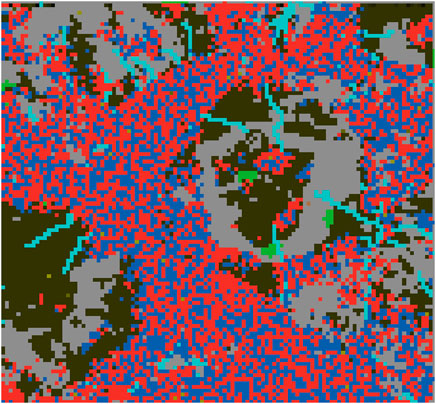
Figure 2. End state of the simulation. Clusters of cooperators have disappeared, and defectors (red agents) dominate the map. However, cooperators do not vanish entirely due to specific genetic and spatial dynamics.
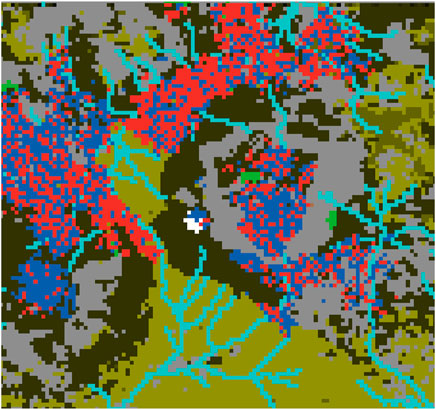
Figure 3. Clustered state of the simulation. We observe clusters of cooperating agents (blue) forming around a proto-Aksumite site in the bottom-left and another near the center of the map.
This outcome highlights the dynamics of cooperation and defection in the system. While cooperation can emerge under favorable conditions in specific areas, defectors tend to invade and destabilize these clusters over time.
3.2 Population dynamics
Figure 4 shows the average agent population over time in two conditions: one with the public-good game enabled (PGG, green), and one without it (No PGG, red). Both simulations display the same broad dynamic pattern: an initial exponential growth, followed by oscillations, and eventual stabilization.
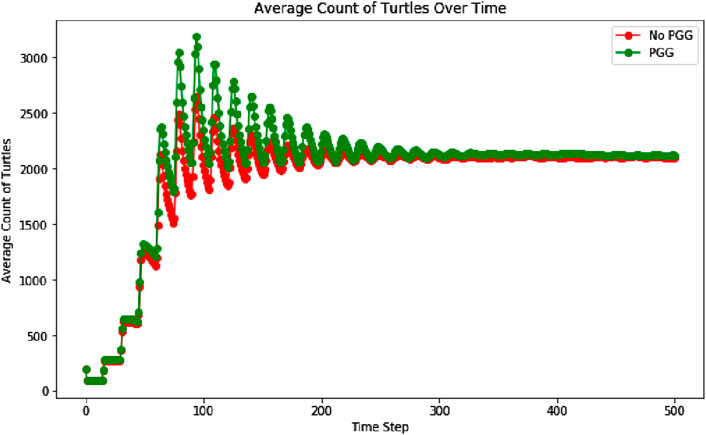
Figure 4. Average agent population over time in scenarios with and without the Public Goods Game (PGG). Results averaged over 100 independent realizations.
These oscillations—present in both runs—are characteristic of Sugarscape-type models, where agents consume local resources, reproduce, then experience crashes as resource availability temporarily falls below metabolic demand. Over time, the system self-regulates, and population stabilizes once a balance between regeneration and consumption is reached.
The key difference lies in amplitude and peak. In the PGG scenario, early cooperation boosts local fertility through successful public-good contributions, allowing the population to grow faster and peak higher (around 3,200 agents) than in the No PGG case (which peaks at 2,400). However, this cooperative advantage is not sustained: as the population increases, donation becomes costlier, fewer agents contribute, and PGG success declines. As a result, the fertility boost collapses, and the PGG population converges back to the same equilibrium level (2,100) as the non-cooperative baseline.
This supports our core argument: cooperation can emerge spontaneously and temporarily raise collective outcomes, but in the absence of additional mechanisms (e.g., punishment, redistribution, coercive leadership), it tends to break down. This mirrors hypotheses in the archaeological and institutional literature that early cooperation likely needed reinforcement to become stable and enduring (Ostrom, 1990; Turchin, 2016).
3.3 Adherence of the results with archaeological data
The demographic trend emerged from the simulation in the PGG scenario reflects, from a qualitative point of view, what we observe in the archaeological record during the early phases of development of Aksum (i.e., throughout the 1st millennium BCE). In this period, for which we have no clear evidence of the presence of leaders exercising coercive power and a political/administrative authority, the settlement system suggests a significant demographic increase to a peak in the very first centuries of the 1st millennium CE (Sernicola, 2017). From this time onwards, demographic trends in the Aksum area reached a phase of general equilibrium, with small fluctuations and changes in the spatial distribution of settlements rather than in their number. This is the period in which we observe in the archaeological record and in the few available written texts the appearance of traits attributable to the leaders’ acquisition of a progressively more political/administrative role (e.g., the beginning of a system of coinage, evidence of donations of land by the king to religious institutions, divine descent of the king, etc.). In this sense, the archaeological data confirms what emerged from the model: the formation of coercive authority helps to keep the system stable by managing cooperation within a larger population. This avoids the population decline observed in the simulation once the threshold of the number of agents willing to cooperate without the presence of a political/administrative authority is reached. The difference between the case-study of Aksum and the simulation is, rather, a quantitative one and is evident above all in the rapidity of the demographic growth observed in the model compared to the archaeological evidence. It will therefore be interesting to reason about the factors that may in reality have contributed to slower population growth. Although the variables and parameters that could have influenced this aspect may be various, an ecological crisis can be ruled out based on environmental data (Southall, 1988). Rather, a higher infant mortality rate or a lower number of individuals per household than assumed based on the ethnographic record may have played a significant role in this respect, as well as a greater mobility of individuals, or, more likely, a major social and cultural changes as attested in this region around the mid-1st millennium BCE. These aspects will be further investigated through targeted archaeological activities in the field and future developments of the ABM simulation, together with the introduction, already in the earliest phases, of ritual leaders/mediators as suggested by the epigraphic record.
3.4 Evolution of cooperative behaviour over time
We track cooperation with two complementary indicators:
1. Incremental PGG successes–the number of newly successful Public-Good Games each tick (Figure 5a).
2. Strategy head-counts–the absolute number of cooperating (yellow) and defecting (orange) agents each tick (Figure 5b).

Figure 5. Temporal dynamics of cooperation. Averages over 100 runs. (a) Mean number of successful PGG at each tick; (b) Number of cooperators and defectors over time.
Together they reveal a three-phase pattern:
The figures show that cooperation persists as a substantial minority rather than disappearing; however, the reduced co-operator pool cannot sustain the early fertility boost, so total population and PGG activity settle at a much lower plateau. This supports our claim that, without enforcement or redistribution, spontaneous cooperation in a growing pre-state society is inherently fragile.
3.5 Statistical significance of population dynamics
Figure 6 displays the p-value trend over time. The horizontal dashed line represents the adjusted significance threshold. Time points where the p-value falls below this threshold (highlighted by red dots) indicate intervals where the agent populations under the PGG and no-PGG conditions are statistically significantly different.
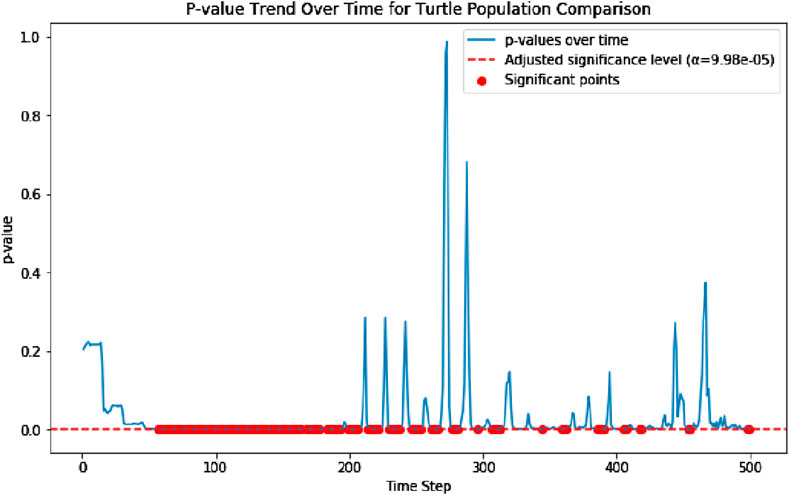
Figure 6. P-value trend over time comparing agent populations in scenarios with and without the Public Goods Game (PGG). Points below the adjusted significance threshold indicate statistically significant differences.
Early in the simulation, the PGG condition sustains significantly higher agent populations compared to the no-PGG condition, supporting the hypothesis that Public Goods Games promote short-term cooperation and demographic success. However, as time progresses and cooperative behavior collapses, the difference between the scenarios diminishes, and the p-values rise above the significance threshold.
This result illustrates that, although cooperation can initially sustain larger populations without coercive institutions, its effect is transient and fragile over long-term dynamics.
3.6 Sensitivity analysis
To test whether our conclusions depend on hand-picked parameter values, we varied one parameter at a time across the widest range that remains archaeologically or biologically plausible and reran 100 realisations for each setting (Figure 7).

Figure 7. Sensitivity of population dynamics to key parameters. Each curve is the mean of 100 runs. (a) Donation-rate (b) Degrade-rate (c) Metabolism-rate.
3.6.1 Donation-rate
Raising the fraction of resources donated in a successful PGG (0.10
3.6.2 Degrade-rate
Slower environmental decay (0.5) sustains fertile patches for longer and produces a higher peak (
3.6.3 Metabolism
Lower metabolic demand (1 unit/tick) allows agents to stockpile sugar and pushes the peak above 7,000. Metabolism = 2 reproduces our baseline. Rates of 3 or 4 deplete resources so quickly that the population crashes below 500 agents and never recovers, showing a clear upper bound for viable energy requirements in this landscape. It is trivial to note that metabolisms so high have no purpose since they lead to quick extinction, which was not the case for the Aksum population.
Across all three levers the system exhibits the same sequence of phases—early boom, damped oscillations, and equilibrium—confirming that our core finding (“short-lived cooperation requires additional institutions to remain effective”) is qualitatively insensitive to wide parameter swings.
4 Discussion
The findings of this study support the idea that social cooperation can emerge in pre-state communities without coercive power, but suggest that such cooperation may be inherently unstable over longer periods. In the PGG-enabled scenario, cooperation initially resulted in resource-sharing and population stability; however, without a coercive authority, the cooperative behavior declined over time: that is because when population size has reached a given threshold, free riding (that is, non-cooperative behavior) becomes evolutionarily convenient, tending to invade the system, unless a top-down intervention reverses such tendency. In sociological terms, we observe that while the population size is small enough to ensure direct social control by everyone on anyone (Nowak and Sigmund, 1998) — mathematically, the social network can be represented by a complete graph (Erdös et al., 1935) — there is no need of any sort of centralized power in order to coerce the free riders (i.e., defectors) to cooperation, for instance by means of punishment (Gintis, 2008). Instead, once the number of members of the society is large enough to allow free riders to avoid strict social control by peers, such central power is needed to maintain a high level of cooperation (Gintis, 2008), as it comes out from our simulations presented in previous sections. Therefore, future simulation models aimed at reproducing this evolution of societies from non-hierarchical to hierarchical structure, have to consider ingredients permitting the emergence of some kind of central power when the level of cooperation falls under a given threshold.
These results and considerations align with Stanish’s theory discussed in the Introduction that while early cooperation is achievable, sustaining it in larger populations requires centralized authority, which can impose penalties or rewards to maintain order.
5 Conclusion
This study provides evidence supporting the hypothesis that pre-state societies may experience cooperation without coercive power in the short term. However, it suggests that, for societies to evolve into complex states, mechanisms of coercion and punishment are likely necessary. These results provide insights into the conditions under which early complex societies may have formed, showing that, while cooperation is possible, sustainable complex social structures may depend on the emergence of centralized authority.
It also drives attention to a fundamental concept of interest to archaeology as an anthropological discipline, namely, that social development of human groups is not a straightforward, unidirectional shift from simpler to more complex forms–i.e., from “bands” to “chiefdoms” to “states” or “kingdoms”. Such western evolutionary model has traditionally permeated the analysis of social organization in Africa’s history–including the one on the emergence, development and decline of Aksum’s polity –, totally ignoring the wide range of African alternative models for complex social organization and inter-groups interaction patterns. Moreover, the study introduces a variety of salient factors that have only rarely been considered in the analysis of the organization and variation in complex societies in Africa. Among them are the following: the very concept of “complexity”, which is not necessarily synonymous with hierarchization or centralization; the significance of ritualized economy as key element in supralocal organization of distantly related or unrelated people; the constant dialogue between forms of resistance to loss of autonomy and the structures of emergent hierarchies and political centralization; and the variety in the forms of power (economic, political, societal and ritual/ideological). Ritual power is crucial in traditional African societies, where a ritual leader - who is not necessarily a political leader - is recognized once credited with superior ability to make rain and ensure the fertility of plants, animals and woman, but having no coercive power. Further developments of this study will make it possible to identify the key factors that determined the transition from one form of social organisation to another and, likely, the thresholds beyond which the system needed to reorganize itself in order to reach a new phase of equilibrium. Theoretical models such as the “Internal African Frontier”, the “First Comers Model” and the “New Comers Model” (McIntosh, 1999) will be tested to reconstruct the dynamics of social interaction in the area of Aksum and their outcomes to verify which of them best fit the available archaeological record during Aksum’s different chronological/cultural phases. The “Segmentary State Model” will be tested for the period of greater territorial expansion and centralized social organization of Aksum’s polity. The Segmentary State is held together by ritual suzerainity, with a centralized core and tenuous unity (Southall, 1988). Regional chiefs duplicated the king but on a smaller scale and with usually minimal formal lines of communication between the king and the regional chiefs, who had no representatives in the king’s village. The king traveled around the kingdom at regular intervals to collect tributes gathered by the regional chiefs. This aspect also matches with the content of the majority of Aksumite royal inscriptions. The segmentary state hypothesis may be applied to many societies in Africa until nominally unified by European administrations; for the Ethiopian state it is not new as Weissleder in 1967 studied the Amhara kingdom as a segmentary state (Weissleder, 1965).
In short, next steps of this research are by a side, finding further archaeological confirmations of the dynamics suggested by our simulations and, as we have already hinted above, conceiving new theoretical models and algorithms in order to get the emergence of a hierarchical structure of societies automatically when the external and internal conditions urge such evolution.
Data availability statement
The raw data supporting the conclusions of this article will be made available by the authors, without undue reservation.
Author contributions
RV: Conceptualization, Data curation, Formal Analysis, Funding acquisition, Investigation, Methodology, Project administration, Resources, Software, Supervision, Validation, Visualization, Writing – original draft, Writing – review and editing. GF: Conceptualization, Data curation, Investigation, Supervision, Writing – original draft, Writing – review and editing. LS: Conceptualization, Data curation, Investigation, Supervision, Validation, Writing – original draft, Writing – review and editing. DV: Conceptualization, Data curation, Formal Analysis, Investigation, Methodology, Project administration, Resources, Software, Supervision, Validation, Visualization, Writing – original draft, Writing – review and editing. CM: Conceptualization, Formal Analysis, Funding acquisition, Project administration, Resources, Supervision, Validation, Visualization, Writing – original draft, Writing – review and editing, Data curation, Investigation, Methodology, Software.
Funding
The author(s) declare that financial support was received for the research and/or publication of this article. This study was financially supported by specific funds for open-access publishing of the University of Siena and by funds available at the Department of Information Engineering and Mathematics of the University of Siena.
Acknowledgments
The paper is part of the following project: “TRASAP: La trasmissione dei saperi fra oralità e scrittura: una ricerca comparata di/in contesto afro-mediterraneo”, a university research program carried out at the University of Naples L'Orientale between 2022 and 2024 coordinated by Prof. Riccardo Palmisciano. The authors thank Prof. Domenico Prattichizzo for the financial support provided for the publication.
Conflict of interest
The authors declare that the research was conducted in the absence of any commercial or financial relationships that could be construed as a potential conflict of interest.
The author(s) declared that they were an editorial board member of Frontiers, at the time of submission. This had no impact on the peer review process and the final decision.
Generative AI statement
The author(s) declare that Generative AI was used in the creation of this manuscript. For formatting and spell checking the manuscript.
Publisher’s note
All claims expressed in this article are solely those of the authors and do not necessarily represent those of their affiliated organizations, or those of the publisher, the editors and the reviewers. Any product that may be evaluated in this article, or claim that may be made by its manufacturer, is not guaranteed or endorsed by the publisher.
Supplementary material
The Supplementary Material for this article can be found online at: https://www.frontiersin.org/articles/10.3389/fcpxs.2025.1590952/full#supplementary-material
References
Bernand, É., Drewes, A. J., and Schneider, R. (1991). Recueil des inscriptions de l'Éthiopie des périodes pré-axoumite et axoumite, I-II. Paris: Académie des inscriptions et belles lettres.
Bowersock, G. W. (2013). The throne of adulis: red Sea wars on the eve of islam. Oxford University Press.
Carneiro, R. L. (1970). A theory of the origin of the state. Science 169 (3947), 733–738. doi:10.1126/science.169.3947.733
Epstein, J. M., and Axtell, R. (1996). Growing artificial societies: social science from the bottom up. Washington, D.C.: Brookings Institution Press.
Fattovich, R. (2010). The development of ancient states in the northerner horn of Africa, c. 3000 BC - AD 1000: an archaeological outline. J. World Prehist. 23, 145–175.
Gintis, H. (2008). Punishment and cooperation. Science 319 (5868), 1345–1346. doi:10.1126/science.1155333
Ledyard, J. O. (1995). “2. Public goods: a survey of experimental research,” in The handbook of experimental economics. Editors J. H. Kagel, and A. E. Roth (Princeton, NJ: Princeton University Press), Chapter 2, 111–194.
Manzo, A. (2005). “Aksum trade and the Red Sea exchange network: a view from bieta giyorgis (Aksum),” in People of the Red Sea. Proceedings of Red Sea project II held in the British museum – october 2004. Editor J. C. M. Starkey (Oxford: Archaeopress), 51–66.
McIntosh, S. K. (1999). Beyond chiefdoms: pathways to complexity in Africa. Cambridge University Press.
Munro-Hay, S. (1982). The foreign trade of the Aksumite port of Adulis. Azania Archaeol. Res. Afr. 17, 107–125. doi:10.1080/00672708209511302
Munro-Hay, S. C. (1996). “Aksumite overseas interests,” in The Indian ocean in antiquity. Editor J. E. Reade (London/New York: Kegan Paul International), 403–416.
Nowak, M. A., and Sigmund, K. (1998). Evolution of indirect reciprocity by image scoring. Nature 393 (6685), 573–577. doi:10.1038/31225
Ostrom, E. (1990). Governing the commons: the evolution of institutions for collective action. Cambridge University Press.
Phillipson, D. W. (2012). Foundations of an african civilization: Aksum and the northern horn, 1000 BC–ad 1300. James Currey. Martlesham, Suffolk, Uinted Kingdom: Boydell & Brewer Ltd.
Sernicola, L. (2017). “Ancient settlement patterns in the area of Aksum (tigray, northern Ethiopia) – Ca,” in 900 BCE - 800/850 CE (BAR international series 2860). Oxford: BAR Publishing.
Southall, A. (1988). The segmentary state in Africa and asia. Comp. Stud. Soc. Hist. 30 (1), 52–82. doi:10.1017/s0010417500015048
Szabó, G., and Fáth, G. (2007). Evolutionary games on graphs. Phys. Rep. 446 (4–6), 97–216. doi:10.1016/j.physrep.2007.04.004
Turchin, P. (2016). Ultrasociety: how 10,000 years of war made humans the greatest cooperators on Earth. Chaplin, CT: Beresta Books.
Keywords: Agent Based Model, game theory, Aksum, archeology, complex systems, public good game
Citation: Vasellini R, Ferrandino G, Sernicola L, Vilone D and Mocenni C (2025) Cooperative behavior in pre-state societies: an agent based approach to the Axum civilization. Front. Complex Syst. 3:1590952. doi: 10.3389/fcpxs.2025.1590952
Received: 10 March 2025; Accepted: 26 May 2025;
Published: 18 June 2025.
Edited by:
Sayan Gupta, Indian Institute of Technology Madras, IndiaReviewed by:
Sylvie Huet, Institut National de recherche pour l’agriculture, l’alimentation et l’environnement (INRAE), FranceIoannis P. Antoniades, Aristotle University of Thessaloniki, Greece
Copyright © 2025 Vasellini, Ferrandino, Sernicola, Vilone and Mocenni. This is an open-access article distributed under the terms of the Creative Commons Attribution License (CC BY). The use, distribution or reproduction in other forums is permitted, provided the original author(s) and the copyright owner(s) are credited and that the original publication in this journal is cited, in accordance with accepted academic practice. No use, distribution or reproduction is permitted which does not comply with these terms.
*Correspondence: Riccardo Vasellini, ci52YXNlbGxpbmlAc3R1ZGVudC51bmlzaS5pdA==; Chiara Mocenni, Y2hpYXJhLm1vY2VubmlAdW5pc2kuaXQ=
 Riccardo Vasellini
Riccardo Vasellini Gilda Ferrandino
Gilda Ferrandino Luisa Sernicola
Luisa Sernicola Daniele Vilone
Daniele Vilone Chiara Mocenni
Chiara Mocenni